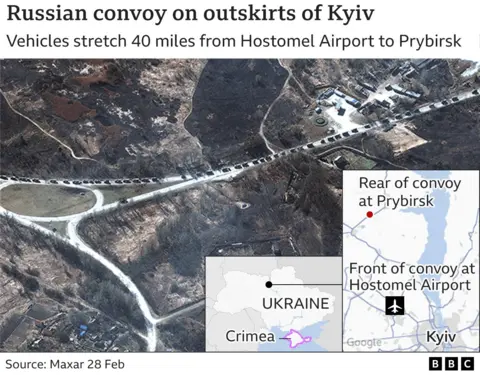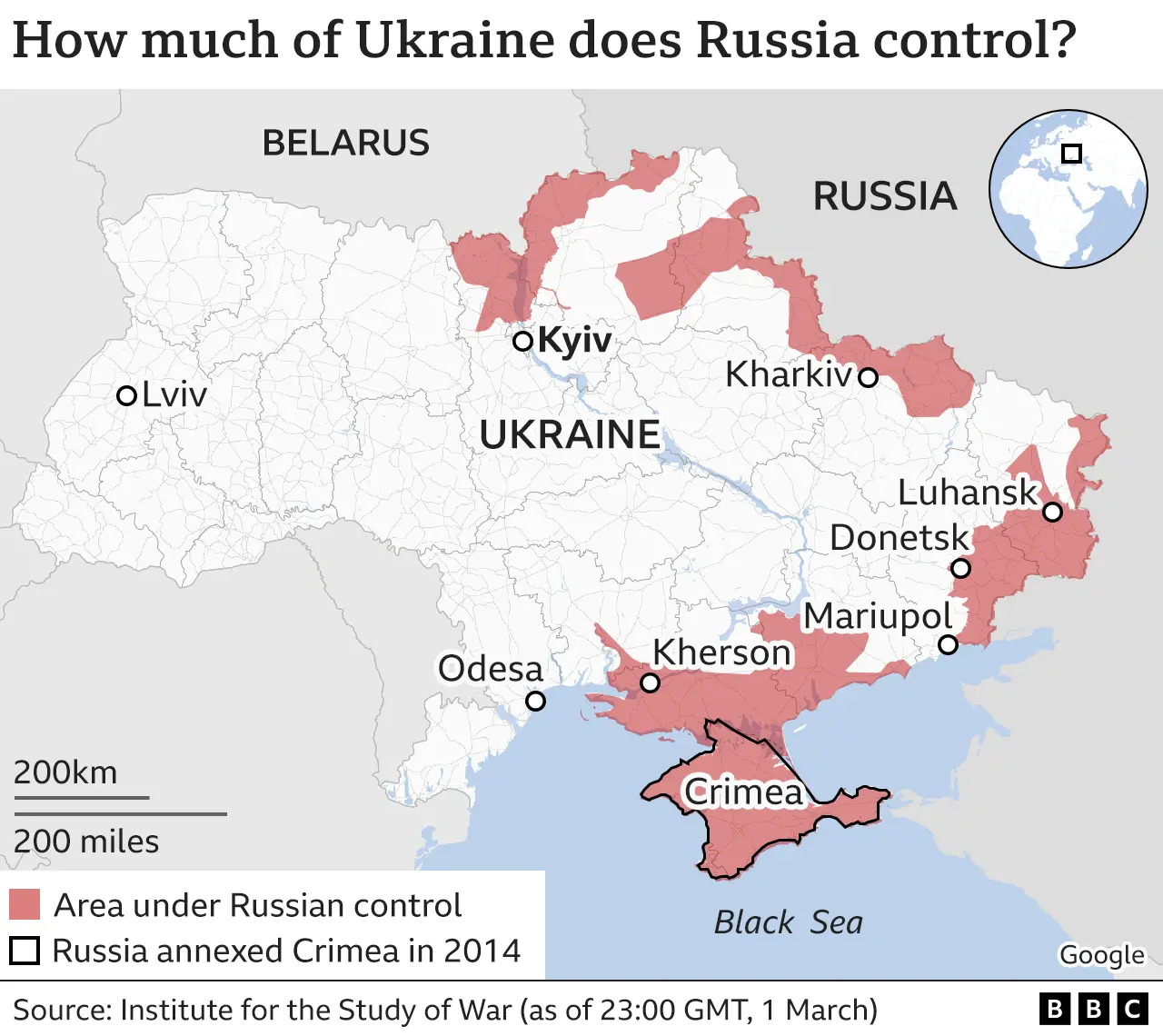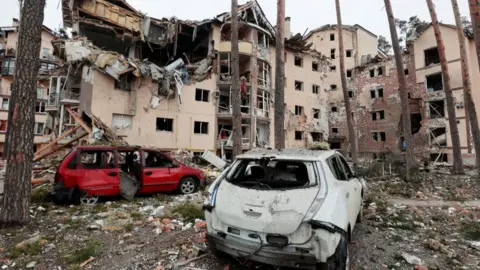Ukraine: Why has Russia's 64km convoy near Kyiv stopped moving?
Russia's huge military convoy, said to be 40 miles (64km) long, near Ukraine's capital Kyiv has hardly moved in three days, the UK defence ministry says.
But US defence officials say Russia still intends to surround and seize the city where some three million people live - by siege tactics if necessary.
Recent satellite images showing the size of the convoy sparked fears that an attack would be imminent.
But UK and US officials say logistical problems could be slowing the advance.
In an intelligence update on Thursday morning, the UK Ministry of Defence said the column had made "little discernible progress in over three days" and remains more than 30km from Kyiv.
Why has the convoy stalled?
Several reasons could explain why the huge column, which includes armoured vehicles, tanks, and towed artillery, has stopped its advance on the capital. They include logistical problems, unexpected Ukrainian resistance, and low morale among Russian troops.
Mechanical breakdown and congestion are causing problems, according to the UK government. Food and fuel are said to be in short supply, and there are reports that poor quality and badly maintained tyres may also be an issue.
"There's a massive logistical failure to provide fuel, food, spare parts and tyres... they got stuck in the mud in a way that makes it difficult to move vehicles out," General Sir Richard Barrons, former Commander of the UK Joint Forces Command, told BBC Radio 4's Today Programme.


However, he said that command and control issues - for example faulty radio networks and communicating on open networks - are likely to be causing bigger problems.
The Pentagon also said Russia was having logistical issues and had taken the decision to deliberately regroup and reassess the "progress they have not made and how to make up the lost time".
Ukrainian resistance is also thought to be hampering the progress of the convoy, according to the Pentagon, although it noted that it could not fully independently verify that claim.
The stronger-than-expected Ukrainian resistance could also be impacting on Russian morale - another reason given for the convoy's lack of movement.
"The overall morale of people sitting in this convoy is going down every day," Oleksandr Danylyuk, a former Secretary of the National Security and Defence Council for Ukraine told the BBC, comparing that with the strong motivation of the Ukrainian military to defend its capital.
On Tuesday, a US defence official told reporters that there were signs of morale problems in the Russian force, which makes use of a large number of conscript soldiers.
"Not all of them were... even aware that they were going to be sent into a combat operation," the official said.


Could the convoy be destroyed?
Ukraine does have some air capability, and has been using powerful Turkish-made drones to destroy other Russian convoys. But according to Gen Barrons, Kyiv simply does not have the military force necessary to destroy a column of this size.
"They've been good at attacking the convoy from the front and sides," he said, but any damage inflicted from the air would be too localised.
Russia will also have air defences around the convoy which could bring down Ukrainian targets, Gen Barrons added. So an air attack on the convoy would risk losing more of Ukraine's already limited air force.
Some commentators have suggested that Nato should consider destroying the convoy, but that would be a major escalation which would risk war between two nuclear powers.
Western governments have said repeatedly that they have no intention of getting directly involved in the conflict.

Russia attacks Ukraine: More coverage
- LIVE: Latest updates from on the ground
- THE BASICS: Why is Putin invading Ukraine?
- INNER CIRCLE: Who's in Putin's entourage, running the war?
- UKRAINE: 'I have never felt so much love for my homeland'
- IN DEPTH: Full coverage of the conflict

What will the convoy do next?
Despite all the reported problems, the fact remains that a huge column of Russian military equipment is located to the north of Kyiv and at some point it is likely to advance.
"This enormous column...will encircle and lay siege to the capital," the former head of the British Army, General Lord Dannatt, told the BBC, adding that an attempt by the Russians to take Kyiv street by street would be hugely damaging.
 Reuters
ReutersAnd Gen Barrons said the convoy still contained a lot of military capability which could bring great harm to Kyiv.
He said the convoy was likely to become part of a force that would encircle Kyiv with a combination of artillery and infantry.
At that point, he said, the Russians would have two choices. Either issue an ultimatum to surrender, or recognise that the city would not give up and attack it in the same way they have in Ukraine's second city, Kharkiv.
For now the people of Kyiv can only watch and wait to see what the convoy does next.
